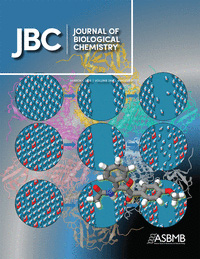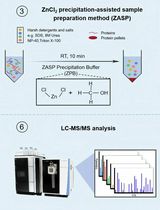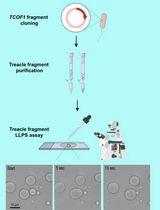- EN - English
- CN - 中文
Identification of Target Protein for Bio-active Small Molecule Using Photo-cross Linked Beads and MALDI-TOF Mass Spectrometry
光交联微球和MALDI-TOF质谱法鉴定生物活性小分子靶蛋白
发布: 2020年02月05日第10卷第3期 DOI: 10.21769/BioProtoc.3517 浏览次数: 5679
评审: Gal HaimovichAlexandros C KokotosMartin V Kolev
Abstract
Development of methods for protein identification is one of the important aspects of proteomics. Here, we report a protocol for the preparation of compound conjugated beads by photo-crosslinking, affinity purification, gel electrophoresis, and highly sensitive mass spectrometric assay for drug-target identification. Although there are several other methods used for drug-target identification, such as biochemical fractionation or radioactive ligand binding assay, affinity purification is widely used for its straight-forward and easy approach. To identify the target protein of an inhibitor of cancer cell-accelerated fibroblast migration, we prepared the inhibitor-conjugated beads by photo-crosslinking. Proteins were pulled down from cell lysates by the compound beads and separated by SDS-PAGE, and a specifically pulled down protein was cut out, trypsin-digested, analyzed using matrix-assisted laser desorption ionization/time of flight mass spectrometry (MALDI-TOF-MS) and identified by peptide mass fingerprinting (PMF) method. Since the photo-crosslinking enables the immobilization of ligands on an affinity matrix in a functional group-independent manner, we do not have to determine the functional group of the compound to conjugate the matrix. In addition, as compared to other MS techniques such as electrospray ionization, MALDI offers a less complex sample preparation procedure and higher sensitivity, and thus is better suited for the rapid identification of proteins isolated by gel electrophoresis.
Keywords: Protein (蛋白)Background
The field of chemical proteomics is of great importance to drug discovery research enabling the identification and validation of a drug target and understanding the side effects as well as designing of more specific drugs. In our research, we used photo-crosslinked small molecule affinity matrix as a tool for identification of target protein of compound NPD8733, an inhibitor of cancer cell-accelerated fibroblast migration. The sepharose beads conjugated with NPD8733 and its control compound without activity were prepared by the photo-crosslinking technique (Kanoh et al., 2005; Suvarna et al., 2019). The proteins pulled down by the beads were separated using standard electrophoresis method. The protein pulled-down specifically by NPD8733-conjugated beads was cut out, subjected to in-gel trypsin digestion, and identified to be valosin-containing protein (VCP) using MALDI-TOF-MS and PMF analysis (Suvarna et al., 2019).
Pull-down assay using affinity beads is a commonly used method for identification of direct targets of small bioactive molecules. The preparation of affinity beads usually requires analysis of structure-activity relationship (SAR) so that the sites that do not affect the activity of the biomolecule can be identified and used for the attachment of an affinity tag such as biotin. Photo-affinity beads developed by Kanoh et al. overcome these drawbacks (Kanoh et al., 2005). The affinity beads prepared by photo-crosslinking technique, do not require SAR studies, since the photo-crosslinking technique utilizes a photo-generated carbene species to immobilize the small molecule on an affinity bead in a chemo- and site-nonselective manner. This unbiased nature of the photo-crosslinking technique proves beneficial for identifying the binding partners of unreactive small molecules; however it cannot be used for the small molecules that degrade upon UV irradiation (Kanoh et al., 2005).
The pulled-down proteins can be separated from the beads using electrophoretic protein separation under denaturing conditions or can also be directly digested on-beads using proteolytic enzymes. The electrophoretic method is inexpensive, easy to use, and has a wide separation range, making relative quantification easy. The separated proteins can be stained using Coomassie blue staining or silver staining methods. The resulting mixture of peptides can be analyzed using MS techniques such as MALDI-TOF or ESI-MS. When compared to ESI, MALDI-TOF is sensitive, requiring low picomole-level of gel-separated proteins. The sample preparation in MALDI is simple and thus suitable for rapid protein identification (Lubec and Afjehi-Sadat, 2007).
The photo-crosslinking method can also be applied for chemical arrays that can be used for ligand screening of a protein of interest. Since small molecules can be fixed in a functional group-independent manner, glass slides with thousands of compounds can be prepared without the need for SAR analysis, also making it possible to study SAR of compounds in a high-throughput manner as well (Kanoh et al., 2006).
Materials and Reagents
- 50 ml Falcon tubes
- Cloth
- Eppendorf tubes
- Micropipette loading tips for pull-down assay (Sorenson, catalog number: 13791)
- 15 cm Petri-dish for cell culture (Iwaki, catalog number: 3030-150)
- Glass vials (Maruemu Corp., No.2, catalog number: 5-098-04), 6 ml
- NHS beads (GE Healthcare, NHS-activated Sepharose 4 Fast Flow 25 ml, catalog number: 17090601)
- Photoaffinity PEG linker (Kondoh et al., 2015)
- Test compound (any vendor). In addition to the test compound, structurally similar and inactive compound was used as the negative control. We have frequently experienced that negative compound conjugated beads act as better “negative control beads” when compared to the naked beads
- Spin column (GeneDesign, Inc., EconoSpin Empty Column, catalog number: EP-31301)
- Mouse embryonic fibroblast cell line NIH3T3 (obtained from RIKEN Cell Bank, catalog number: RCB1862)
- Human breast cancer cell line MCF7 (obtained from RIKEN Cell Bank, catalog number: RCB1904)
- Dulbecco's Modified Eagle Medium (D-MEM) media (Gibco, catalog number: C11995500BT)
- Fetal calf serum (FCS) (Nichirei Bioscience Inc. Tokyo, Japan) used at 10% in DMEM
- Penicillin and Streptomycin (Pen Strep, Gibco, catalog number: 15140-122) used at 100x dilution in DMEM
- HEPES (Sigma, catalog number: H3375)
- HCl (FUJIFILM Wako Pure Chemical, catalog number: 080-01066)
- NaCl (FUJIFILM Wako Pure Chemical, catalog number: 191-01665)
- KCl (FUJIFILM Wako Pure Chemical, catalog number: 163-03545)
- Na2HPO4·12H2O (FUJIFILM Wako Pure Chemical, catalog number: 196-02835)
- KH2PO4 (FUJIFILM Wako Pure Chemical, catalog number: 169-04245)
- Dioxane (FUJIFILM Wako Pure Chemical, catalog number: 042-03766)
- MQ-water (Purified water produced by MilliQ Q-POD, Millipore)
- NaN3 (FUJIFILM Wako Pure Chemical, catalog number: 199-11095)
- EDTA (FUJIFILM Wako Pure Chemical, catalog number: 345-01865)
- Sequencing Grade Modified Trypsin (Promega, catalog number: V5111)
- Acetonitrile (Nacalai tesque, catalog number: 00420-41)
- TFA (FUJIFILM Wako Pure Chemical, catalog number: 201-06393)
- Methanol (FUJIFILM Wako Pure Chemical, catalog number: 131-01826)
- α-Cyano-4-hydroxycinnamic acid (FUJIFILM Wako Pure Chemical, catalog number: 037-19261)
- NaHCO3 (FUJIFILM Wako Pure Chemical, catalog number: 191-01305)
- NH4HCO3 (FUJIFILM Wako Pure Chemical, catalog number: 017-02875)
- Ethanolamine (FUJIFILM Wako Pure Chemical, catalog number: 012-12455)
- Tris (FUJIFILM Wako Pure Chemical, catalog number: 201-06273)
- DTT (FUJIFILM Wako Pure Chemical, catalog number: 042-29222)
- Iodoacetamide (FUJIFILM Wako Pure Chemical, catalog number: 093-02892)
- Coomassie Brilliant blue R250 (CBB) (FUJIFILM Wako Pure Chemical, catalog number: 031-17922)
- Acetic acid (FUJIFILM Wako Pure Chemical, catalog number: 017-00256)
- Isopropanol (FUJIFILM Wako Pure Chemical, catalog number: 325-00045)
- Sodium Dodecyl Sulfate (SDS) (FUJIFILM Wako Pure Chemical, catalog number: 192-08672)
- Bromophenol blue (FUJIFILM Wako Pure Chemical, catalog number: 021-02911)
- Glycerol (FUJIFILM Wako Pure Chemical, catalog number: 075-00611)
- 2-Mercaptoethanol (FUJIFILM Wako Pure Chemical, catalog number: 28625.01)
- Ammonium Persulfate (APS) (FUJIFILM Wako Pure Chemical, catalog number: 802811)
- N,N,N’,N’-tetramethylethylenediamine (TEMED) (FUJIFILM Wako Pure Chemical, catalog number: 202-04003)
- Razor (FEATHER, catalog number: 99077)
- cOmplete EDTA-free Protease inhibitor cocktail tablet (Roche diagnostic, Mannheim, Germany, catalog number: 11836170001)
- Pierce BCA protein assay kit (Thermo Fisher Scientific, catalog number: 23225)
- Wash/binding buffer containing protease inhibitors (see Recipes)
- 1x SDS buffer (see Recipes)
- Binding/wash buffer (see Recipes)
- aq. HCl (see Recipes)
- PBS (see Recipes)
- Coupling buffer (see Recipes)
- Blocking solution (see Recipes)
- Decolorant (see Recipes)
- Reduction solution (see Recipes)
- Alkylating solution (see Recipes)
- Digestion solution (see Recipes)
- Extraction solution 1 (see Recipes)
- Extraction solution 2 (see Recipes)
- Matrix solution (see Recipes)
- Staining solution (see Recipes)
- Destaining solution (see Recipes)
- 10x Tris-glycine running buffer (see Recipes)
- 5% Stacking gel (see Recipes)
- 10% Resolving gel recipe (see Recipes)
Equipment
- UV crosslinker (UVP, Ultraviolet Crosslinker, CL-1000)
- LCMS (LC: Waters, ACUITY UPLC H-class, MS: SCIEX, API 3200 LC-MS/MS)
- Agilent Oven (Agilent Technologies, Hybridization Oven, G2545A)
- High-performance rotary evaporator (Scrum, Genevac, EZ-2 plus)
- Rotator (TAITEC, model: RT-50)
- Desk-top centrifuge machine (Corning, model: 6765)
- Standard refrigerated centrifuge for 15/50 ml and Eppendorf tubes (Tomy, model: MX-301)
- Savant SpeedVac Concentrator (ThermoFisher Scientific, model: SVC100H)
- Heat block (EYELA, model: MG-1200)
- Ultrasonic bath (AS ONE, US CLEANER US-1R)
- Sonicator (Tomy, model: UR-20P)
- Slab type SDS-electrophoresis equipment (NIHON-EIDO, model: NA-1010)
- MALDI-TOF mass spectrometer (Ultraflex, Bruker Daltonik GmbH)
Software
- Biotools (Biotools version 3.2, Bruker Daltonik GmbH, https://www.bruker.com/)
- Mascot search program (Mascot Server, Matrix Science Inc, http://www.matrixscience.com)
Procedure
文章信息
版权信息
© 2020 The Authors; exclusive licensee Bio-protocol LLC.
如何引用
Readers should cite both the Bio-protocol article and the original research article where this protocol was used:
- Suvarna, K., Honda, K., Muroi, M., Kondoh, Y., Watanabe, N. and Osada, H. (2020). Identification of Target Protein for Bio-active Small Molecule Using Photo-cross Linked Beads and MALDI-TOF Mass Spectrometry. Bio-protocol 10(3): e3517. DOI: 10.21769/BioProtoc.3517.
- Suvarna, K., Honda, K., Muroi, M., Kondoh, Y., Osada, H. and Watanabe, N. (2019). A small-molecule ligand of valosin-containing protein/p97 inhibits cancer cell-accelerated fibroblast migration. J Biol Chem 294(9): 2988-2996.
分类
癌症生物学 > 癌症生物化学 > 蛋白质
生物化学 > 蛋白质 > 分离和纯化
您对这篇实验方法有问题吗?
在此处发布您的问题,我们将邀请本文作者来回答。同时,我们会将您的问题发布到Bio-protocol Exchange,以便寻求社区成员的帮助。
提问指南
+ 问题描述
写下详细的问题描述,包括所有有助于他人回答您问题的信息(例如实验过程、条件和相关图像等)。
Share
Bluesky
X
Copy link













